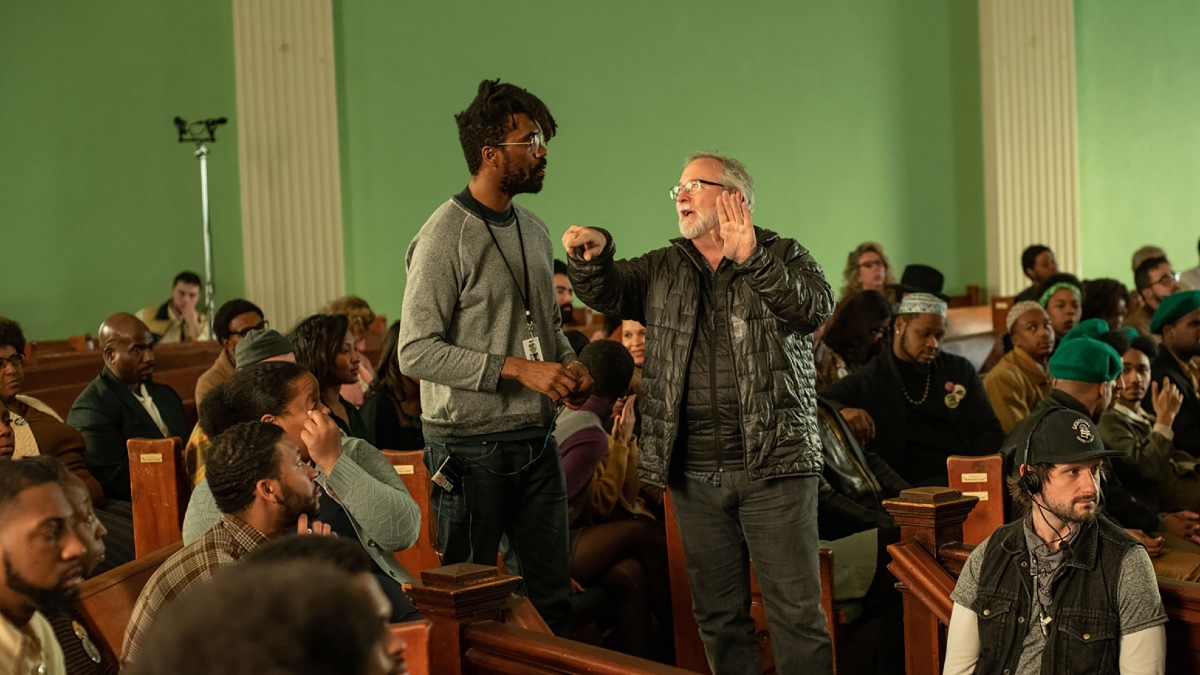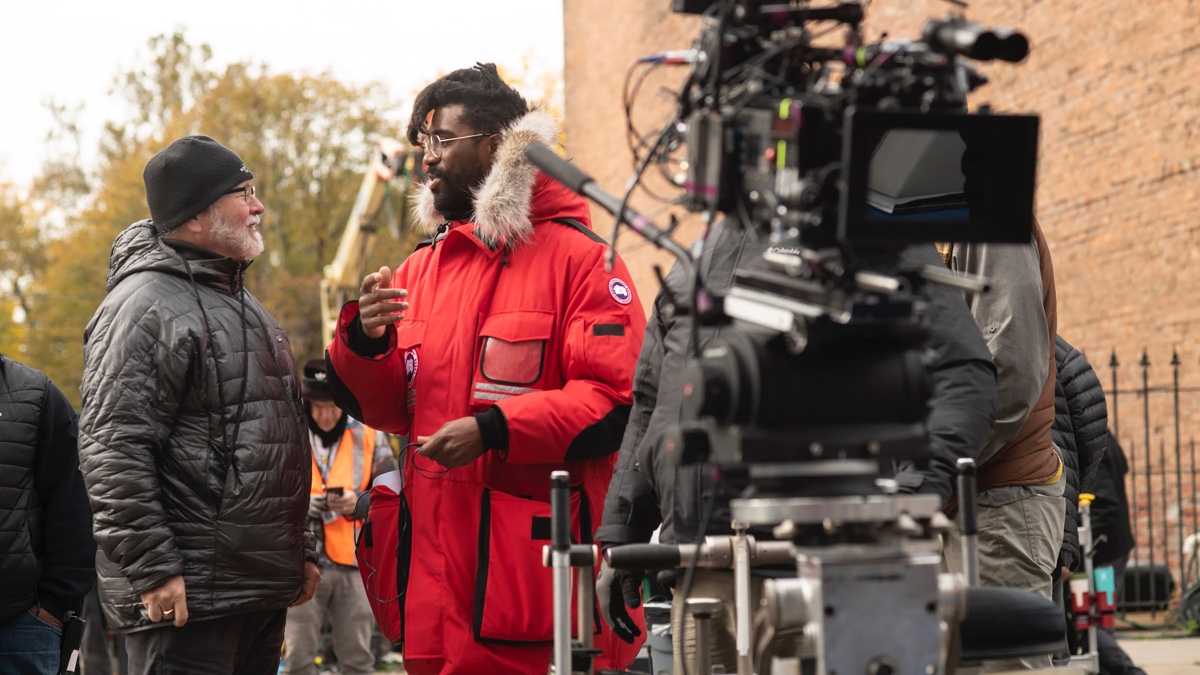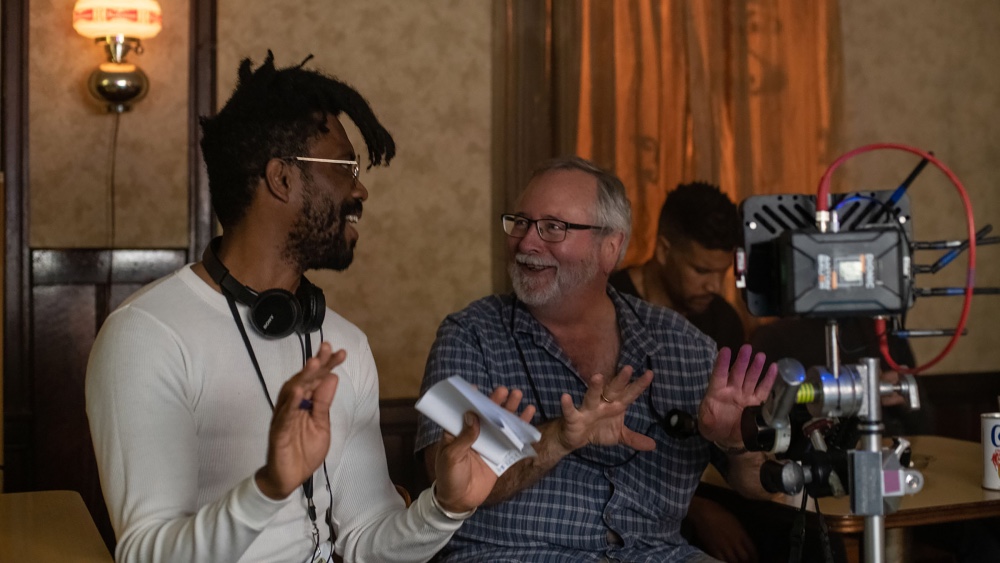
Shaka King’s Judas and the Black Messiah is about Black Panther chairman Fred Hampton, as played by Daniel Kaluuya (Get Out), and how he was hounded and plagued by J. Edgar Hoover’s FBI in the late ’60s. It got to the point where Federal Agent Roy Mitchell (Jesse Plemons) coerced two-bit criminal Bill O’Neil (LaKeith Stanfield) to infiltrate Hampton’s Chicago Black Panther party to keep an eye on the powerful African-American leader.
It’s a film that showcases a Golden Globe and SAG-nominated performance by Kaluuya, as well as powerful moments with the rest of the cast, but it’s also a film that seems to offer a fair share of visual challenges. Because of this, King called upon Sean Bobbitt, BSC, whose amazing work with Steve McQueen, which includes shooting his Oscar-winning 12 Years a Slave, made him the perfect candidate to provide King with his cinematography skills.
Bobbitt’s collaboration with McQueen began with his 2008 feature debut Hunger, and part of what makes Bobbitt so in demand by African-American filmmakers is his ability to capture varying black skin tones in a manner that maintains actors’ varied hues. It’s actually fairly shocking that Bobbitt has yet to be nominated for an Oscar for his work, although both the American and British Society of Cinematographers (ASC, BSC) nominated Bobbitt for his work on 12 Years a Slave.
Below the Line spoke over the phone with Bobbitt for the following interview where he also mentioned that he’d be entering the Marvel Universe by shooting the Captain Marvel sequel with director Nia Dacosta.
Below the Line: For the longest time, I had been under the misconception that you’re British, maybe because you’ve worked so much with Steve McQueen, although the two of you filmed a lot in the United States:
Sean Bobbitt: Well, I’ve spent – off and on – 50 years in the United Kingdom, so I might as well be British.
BTL: I spoke to Steve a few months back, and I was curious why you weren’t shooting the “Small Axe” films, although I guess that’s a big commitment to do five movies.
Bobbitt: I did find Mr. Shabier Kirschner and really briefed him before the film began. There’s some regrets you have in life, and sadly, that’s one of them. Having said that, if I’d done Small Axe, then I wouldn’t have done Judas and the Black Messiah.
BTL: I felt when I was watching Judas and the Black Messiah that it was showing what was happening in America with the Black Panthers around the same time as McQueen’s Mangrove in the UK.
Bobbitt: Absolutely. It’s exactly the same period of time. In the same way that a lot of people in America know nothing of Fred Hampton, the majority of people in the United Kingdom knew nothing about The Mangrove, so I think they’re very timely. Sadly, a lot of the racism is still here — that sort of endemic racism in both British society and American society certainly hasn’t changed that much since the ‘60s. So I think that makes both films very timely.
BTL: Before we talk about that, what was your background — you were a TV camera operator for a long time over there?
Bobbitt: I started as a news cameraman, and I worked freelance for the American networks, based out of London, for 10 years covered England, Ireland, of course, and the whole of Europe, Africa and the Far East. And then transitioned from there into documentaries and did documentaries for about nine years, again, all over the world, based out of London. Then was very fortunate, after several years of trials and tribulations to be pulled out of that world by Michael Winterbottom for a film called Wonderland, and I’ve never looked back since then. So I’m very grateful to Michael.
BTL: How were you connected with Shaka King to shoot Judas?
Bobbitt: The script was sent to me. I read it immediately and could see just the power and the importance of that story, and I was also appalled that I didn’t know the story. Fortunately, I was doing some work in New York soon afterwards, so I was able to meet up with Chaka, and within a couple of minutes of meeting him, it was like, “Yeah, I’m gonna do this film.” His passion, his knowledge, just everything about him. “Yeah, this is gonna be worth doing.”
BTL: Did he come into that meeting with some visual references he wanted to use or had you watched movies from that period like the Agnés Varda, from which a clip of Fred is used?
Bobbitt: Initially, at our first meeting, he had several hundred stills photographs of Chicago from the 1960s, and it was just looking at those and sort of taking in those images. Those sort of became the basic groundwork to the overall look of the film. The thing that really shocked me when looking at all those images is that I’d worked in Chicago about four years before on Widows with with Steve McQueen, and the images I was looking at from the 60s are the images that we were seeing on the streets in Chicago today. When we were recceing for Widows, we were in a lot of the less luxurious parts of town. It was a real eye opener, and then, for financial reasons, they couldn’t shoot the film in Chicago – it was just too expensive. We ended up in Cleveland, and it was astounding. It’s very sad for Cleveland, but it’s kind of been gutted and left behind in the past. There were actually a plethora of locations which fitted exactly with 1960s Chicago look.
BTL: I feel like there are a lot of cities in the Midwest where they’ve been modernized but then you have areas in places like Detroit where parts have been left behind.
Bobbitt: It was a steel city, and the steel mills, I think there’s one or two left now, so the industry has died, and a part of that infrastructure has died as well. There was one area we were filming in that had been very badly damaged in the riots in the late 60s, which had never been fixed up. It had just kind of been left and people moved away. That’s sort of where we based our Black Panther headquarters. It was good for us in terms of some amazing locations, but a real indictment of the state of working America.
BTL: I imagine that you’re also involved with the location scout, and I assume you and Shaka and the production designer are all looking for the right place to shoot this?
Bobbitt: The production designer comes on way before I come on, so he does all of the initial scouting with the director or without the director and is presenting the locations primarily to the director. I just get to come along and have a look. All of that work comes from the production designer, and in this case, Sam Lisenco, who has a fantastic eye and imagination and created a completely believable world that is 1960s Chicago. It’s not every film that you go onto where all the departments are so tightly linked together. The hair and makeup on Judas and the Black Messiah, the costumes, as well as the design, the sound, every aspect of it is there to create that coherent world, which the audience, hopefully, is kind of suspended in for the duration of the film. Quite often it doesn’t work like that, and there are things that jar and throw you out of the film, but I think under the direction of Shaka, everyone knew where we were going and what we were trying to achieve. That’s a lovely and a very rare thing in filmmaking.
BTL: Is film ever part of the conversation any more or are the limitations too much in terms of processing time, etc. vs. the benefits?
Bobbitt: I’ve been very fortunate. I’ve shot on film almost exclusively up to about two years ago. Now, it’s the loss of the labs basically that make it very impossible. We shot Widows, and you have to ship everything to Los Angeles. There’s a cost involved, insurance costs, and then of course, time, which is a bit odd, because for generations, we’ve managed to make films with that time lapse between shooting and seeing the rushes, but for some reason now, it’s not acceptable, which is a great shame. We shot digitally, but on the ARRIA Alexa LF, which is a large format camera. This is the first time shooting on the LF that I didn’t feel kind of cheated, that I wasn’t shooting film, because of the large size of the chip, you get more picture information, more color information, and a wonderful gradation of contrast ratio from black to white. Because of that expanded amount of information, it worked beautifully for us. One of the key desires or demands of the film is that all of the actors’ flesh tones are accurately portrayed. A lot of times, the darker flesh tones, they disappear or they become mushy. We were able to hold the colors and also have very, very dark faces with very light faces in the same frame without having to do any special lighting. It really was actually an asset to be shooting on the LF.
BTL: What was the timeframe for this? When did you shoot this compared to when the pandemic came and sidelined everything?
Bobbitt: We shot this years ago. [chuckles] Well, it seems like years ago. No, we shot this two years ago, so the pandemic, that was an unknown thing. It was a 41-day shoot, so it was fast and furious. I mean, it wasn’t a big budget, but we had crew. There were no crew really in Cleveland, so we had crew from all over America who came in in every department. The really great thing is that they all came, because they wanted to make this film, so the camaraderie, the collaboration, the efforts that everyone went to, to get this film right, it was all made through a desire, as opposed to just pure financial recompense. You’re heading into winter in Cleveland, but no one was complaining — everyone was happy to be there — and Shaka King is a great director and a great leader. He kept it light and kept everyone going, so it was a real pleasure to work on.

BTL: The nighttime exteriors looked particularly great and added so much to the tension. Were you doing day for night or were those scenes all shot at night?
Bobbitt: No, there’s no day-for-night at all. It’s all shot on location at night. Part of the concept of the lighting is to mix all of those colors. In the 60s, when you look back on it, it was sort of a very bright and brash time. By putting in all those different colors in the frame, again, it gives it a slightly different feel and a different look and hopefully, more of a period feel.
BTL: Did you end up doing most of the post before the pandemic?
Bobbitt: No, most of the post was done during the pandemic. I was fortunate, and I’m very grateful to Warner Brothers, because I was in England and had contracted COVID-19 and had been very ill and had not quite recovered. They set up a huge tower in my garden and put a big monitor in the boat so that I could actually grade live with my Colorist Tom Poole in New York and Shaka. My approach to filmmaking, the actual final grade of the film, is absolutely crucial, because that’s where everything comes together.
BTL: I’m glad you recovered from COVID, and I hope you’ve gotten or will get your vaccine soon. Are you planning something to shoot this year?
Bobbitt: I’m hoping to get back. I’m sort of signed up to shoot Captain Marvel II, so that will be a real change for me. It’s a very different type of film to what I usually make, and I’m very excited to be a part of that.
BTL: The director, Nia DaCosta, her first film was really good, but I’m not sure how many people have seen her Candyman movie yet. Maybe you have?
Bobbitt: No, I’m looking forward to seeing it as well — I thought her first film was fantastic. I’m really, really keen to be working with her, very grateful.
BTL: I noticed that you shot Reed Moreno’s The Rhythm Section, which came out last year. She’s a pretty amazing DP in her own right, and I think she was the cinematographer on all her previous films as well, so what was that like working with her?
Bobbitt: That was such a pleasure. I’ve known Reed for a long time, and she is a great cinematographer, and she is also a really great, great director. It was brilliant, because the language that cinematographers speak is not always easily understood by directors. To have someone who could speak in my language, as it were, and understand what I was saying was just unique. As part of that, the ideas would bounce off of each other and grow into something more, which is always exciting. That level of collaboration is really what makes a film interesting for me and hopefully enhances the quality of the film itself.
BTL: That’s great to hear. I’ve been learning more about the art and science of lenses and lights and such since I’ve been here at Below the Line, and it’s great stuff.
Bobbitt: And that’s the joy of it. No job is the same, and there is no right solution. There are endless numbers of solutions to the issues that you’re presented with, but hopefully you come up with the right solution, both technically, but more importantly, in terms of the emotional content and look of the film. So it’s an endless challenge, which has made it even more interesting these days by the changes in technology.
BTL: Do you still do any of the physical camerawork yourself these days?
Bobbitt: I operate on all of the films, and on Judas and the Black Messiah, it’s mainly single camera. I’m not really big on coverage and neither was Shaka King, so we really thought out each sequence, each scene, and tried to find exactly the right place to put the camera, so that the action unfolds in front of it. You’re never drawing attention to the camera, but you’re you’re always seeing what you need to see, and not seeing what you don’t need to see. But operating is a great pleasure – it’s where the fun is, and I never want to give up the fun.
BTL: There’s so many intimate scenes in the movie between Fred and other characters that you can tell it’s a small crew work if you have a huge camera department.
Bobbitt: I try to keep the set completely empty of light stands and hide everything as much as possible. I tend to work with a very quiet crew, where everything’s very calm, very considered, because at the end of the day, it’s the performance of the actors that really makes the film. We sort of put the frame around that, but if you can give them the time, the space, the respect to get on with what they do, then they’re going to do a better job, it’s going to be a better film. For me, that’s very important to the primacy of the performance and not the technical aspects of the film.
BTL: It’s brilliant talking to you, and I’m a little bummed, I haven’t had a chance to see this on the big screen.
Bobbitt: It’s a shame that it’s not on the big screen, because it’s really designed for the big screen and the sound on it, the sound that Shaka and his composers have come up with is just astounding. It really heightens the film to another level in a very unique way in a lot of the sequences.
Judas and the Black Messiah is now playing in select theaters nationwide, as well as on HBO Max. Look for more with the crafts people involved with making the movie very soon. All photos by Glen Wilson, courtesy of Warner Bros.
You can read our review here as well as an interview with Editor Kristan Sprague.






